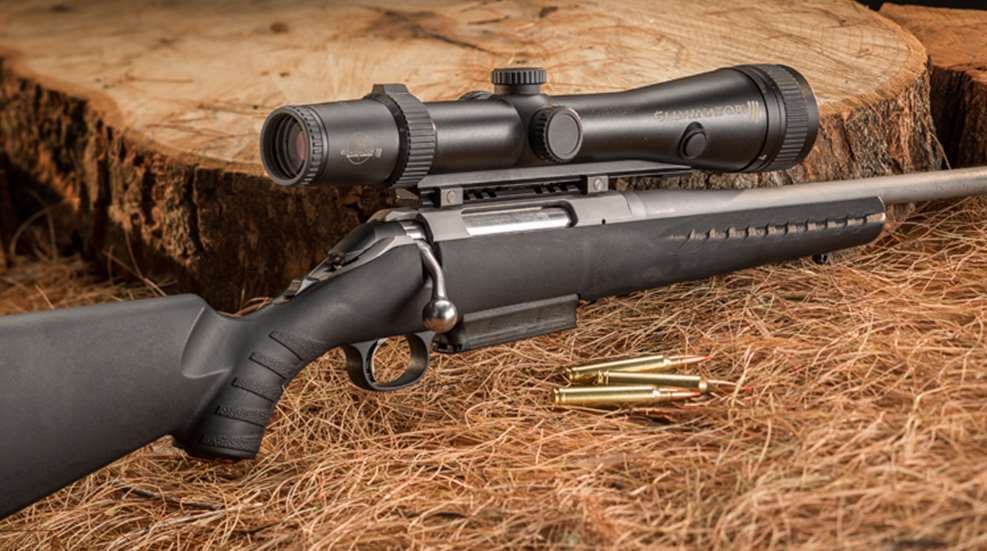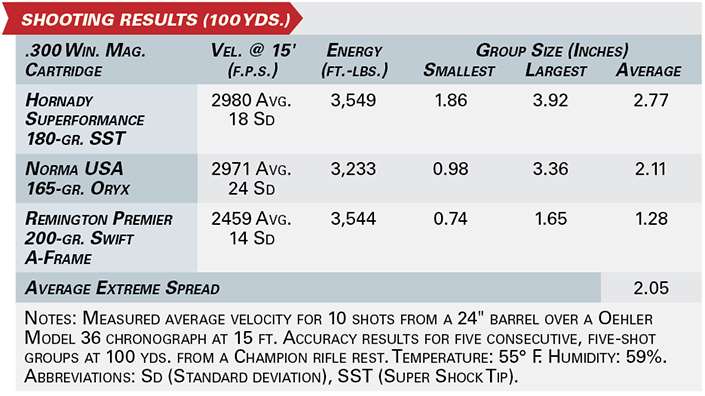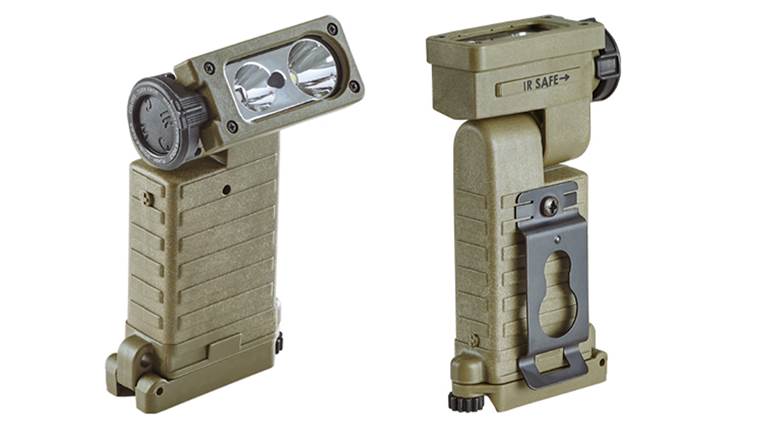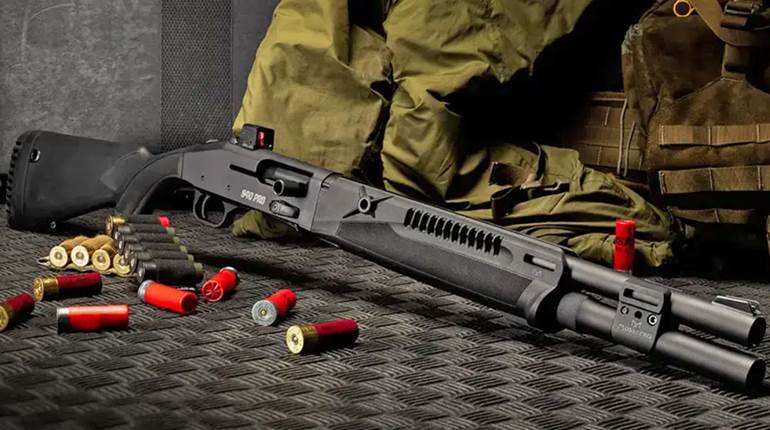
Originally introduced as a short-action center-fire bolt-action, chambered for a handful of the most popular hunting cartridges, the Ruger American Rifle has been phenomenally successful. In fact, it now serves as the basis for an entire line that encompasses almost a dozen rifle models, in nearly two dozen chamberings including rimfire and long-action magnum cartridges. The Ruger American Rifle Magnum is the most recent addition, and at time of writing is available in two chamberings—7 mm Rem. Mag and .300 Win. Mag.—the latter of which is reviewed here.
Starting from the business end, the Magnum features a 24" stainless steel, cold-hammer-forged barrel. During the hammer-forging process, the barrel blank is lengthened and contoured around a mandrel that bears both the chamber and the rifling—in this case, six-groove, 1:10" RH twist. Because these internal characteristics are applied integrally to the barrel’s creation, the cold-hammer-forging process tends to yield consistent, and often accuracy-boosting, results. From the muzzle, the first 0.605" of the barrel is threaded, 5/8-24, to accept muzzle brakes or other devices, such as those available from shopruger.com. Out of the box, the rifle includes a thread-protecting cap that is approximately 0.75" in diameter, tapering as a natural extension of the barrel’s contour, and possessing opposing flats for tightening or removal with a wrench.
The stainless steel receiver is obviously longer and larger than that of the original American in order to accommodate magnum-size cartridges. The Magnum’s full-diameter bolt—wherein the body’s outside diameter is no greater than that of the lugs—is particularly illustrative of the receiver’s upsizing; at 7.75" long and with a nearly 1" body diameter (0.9"), there is an undeniable heft to the entire assembly. A stout, three-lug arrangement ensures secure lockup, and the smooth, cylindrical body glides easily within the receiver. The bolt’s handle is a fairly trim arm curved slightly rearward and capped by a spherical knob. It is dovetailed to the bolt body and can be removed to facilitate bolt disassembly. In action, the smooth movement and 70-degree bolt lift offer a real advantage to shooters, and are a credit to the maker, in that the bolt’s easy operation facilitates keeping eyes on target during manipulation. The receiver features a bolt-stop lever on the left side, opposite the bolt handle’s channel, and a two-position tang safety. The bolt can be removed with the safety in either the Safe- or Fire-position—we, and the Ruger manual, recommend the rifle be unloaded, on Safe and the magazine removed—by withdrawing it while depressing the rear of the bolt stop.

In lieu of sights, the Magnum includes a 5.5" length of factory-mounted Weaver-style rail atop the receiver. The rifle is fed from a three-round, single-column, detachable box magazine. Where the non-magnum American has a flush-mounted rotary magazine, the Magnum’s box protrudes below the stock in order to accommodate a third cartridge. The rifle’s firing mechanism includes a spring-tensioned firing pin that is cocked as the bolt handle is lifted, and released with a 3- to 5-lb. pull on the Ruger Marksman Adjustable trigger—our sample broke, on average, at 4 lbs., 7 ozs. The Marksman Adjustable trigger is of the blade-in-blade design, that is, the trigger has a smaller, central trigger-release lever that is depressed during the trigger pull. We found the trigger to be crisp with no take-up or over-travel.
Finally, the rifle’s synthetic stock is in the same shape and style as the original American center-fire models. Indeed, the same, integral V-block-based Power Bedding system is used to secure the receiver within the stock and free-float the barrel. However, the actual polymer—a glass-filled nylon—is a slightly different material than is found in the non-magnum stocks. The recipe was tweaked just a bit to add some weight to the rifle. The extra ounces are intended to dampen, somewhat, the recoil of the magnum cartridges. For the same purpose, a 1" semi-spongy recoil pad rounds out the American Magnum’s features.
One of our evaluators was able to conduct extensive field testing, spending more than a week hunting the mountains and high plains of South Africa’s Eastern Cape. After stalking plains game over miles of “big country,” he reported that the American Magnum, despite weighing more than 8 lbs. when loaded and topped with an optic, proved to be quite portable—he added that it was a well-balanced rifle and “very handy on the hoof.” The rifle, combined with a Burris Eliminator III 3-12X 44 mm scope and premium Hornady ammunition, also proved deadly accurate on a variety of game—from the small Vaal rhebuck to kudu and eland—and at a variety of ranges—from less than 100 yds. to nearly 500 yds.

On our home range, we tested the same rifle and scope combination with three different .300 Win. Mag. loads: Norma’s 165-gr. Oryx, Hornady’s Superformance 180-gr. SST and Remington’s Premier 200-gr. Swift A-Frame. One thing that became very clear was our rifle’s preference for 200-gr. bullets. The Remington load posted the best group—0.74"—and the best average—1.28" for five, five-shot groups. This was consistent with our hunter’s earlier results, he reports 100-yd. groups averaging 1.25" using Hornady’s 200-gr. ELD-X load. Unfortunately, with lighter bullets the rifle was consistently inconsistent. Full results are tabulated nearby, but our conclusion is that the American Magnum will likely prefer specific loads, and not perform as well with others. These findings, however, should not deter potential buyers—quite the opposite. At the end of the day, the American Magnum is a long-action rifle from a respected maker that, with the right ammunition, is capable of sub-minute-of-angle accuracy. Even better, the suggested price is less than $700. That is a lot of rifle for the money. Indeed, Ruger’s line of American bolt-action rifles may represent the best value in the new-firearms market today.






































